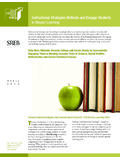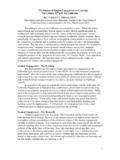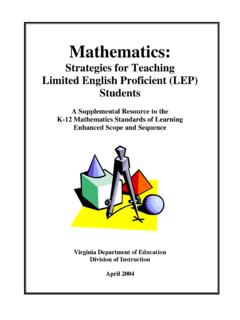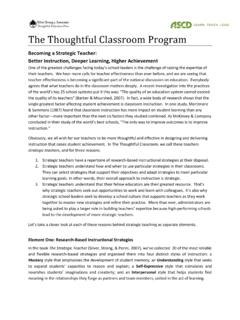Transcription of CHAPTER 2 Teaching Critical Literacy - Educational …
1 Jmy is a member ofa group 35 CHAPTER 2 Teaching Critical LiteracyTeaching Critical Literacy It has taken some time, but my students have learned tocomprehend in a deeper way. It s like when we talk about readingbeyond, under, over, and around the text. When my students areengaged from a Critical perspective, they comprehend beyond,under, over and around their previous level of understanding. BETH GRESS, third grade teacherJennifer is a member of our teacher group. As an advocate of criticalliteracy, she knows, as we do, that knowledge is socially constructed,open-ended, and continuously unfolding. We also know that Critical Literacy is acquired over time through thoughtful deliberation and , it is important that we be patient, thoughtful risk-takers aswe strive to create classroom atmospheres that encourage and challengestudents to become critically teachers, we know that motivation is essential for successful teachingand learning experiences.
2 We want our students to be enthusiasticallyinvolved in their learning, so we strive to use engaging texts and teachingtechniques. We also know that using instructional frameworks helps us tosuccessfully organize, plan, and teach meaningful lessons. In this CHAPTER we focus on these and other aspects of Teaching criticalliteracy. We begin by discussing the engaged learner and describing somemotivational practices. Next, we present two instructional frameworks, oneCHAPTER 2 36 Critical Literacy : Enhancing Students Comprehension of Textthat we use to teach Critical Literacy strategies, and another that we use to teach criticalliteracy lessons in which students apply the strategies. These are followed by descriptionsof Critical Literacy strategies and their classroom applications. Finally, we discuss how toselect texts to use when Teaching Critical Literacy and provide some Can We Motivate Students to Become Critically Literate?
3 As with all aspects of learning, engagement and motivation are key factors when teachingcritical Literacy . We want our students to choose to be actively engaged and to constructpersonal meaning. Engaged learners are characterized as:uachieving because they want to understandupossessing intrinsic motivations for interacting with textuviewing reading as a thinking processusharing knowledge through discussion with teachers and peersureading for different purposesuutilizing background knowledge, and socially constructing meaning (Guthrie & Wigfield, 1997; Baker & Wigfield, 1999) As teachers, we can nurture engagement by encouraging students to read for authenticpurposes, make personal connections, focus on comprehension, and respond in meaningful ways. To foster student motivation, we should be good reading models, create book-richenvironments, provide opportunities for choice, promote familiarity with books in various genres, and offer incentives that reflect the values of reading (Gambrell 1996).
4 Gambrell, Palmer, Codling, and Mazzoni (1996) note that highly motivated readers readfor a wide variety of reasons including curiosity, involvement, social interchange, andemotional satisfaction. There is a wide variety of ideas and conditions that motivate students to read. We may already be using some of these ideas in our Teaching ; others may be new. Theyinclude but are not limited to: 37 CHAPTER 2 Teaching Critical LiteracyuMaking reading, writing, speaking, listening, and viewing pleasurable, and providing sufficient time for students to engage in these activities. uCreating a classroom library that includes multiple levels of narrative and informational texts, addresses a wide range of interests, provides access to a variety of genres, and promotes Critical time for active, creative responses to texts using discussion and multiplemodes of response (writing, sketching, dramatizing, singing, projects, and so on)to promote Critical analysis and creation of a range of new and valuing students independent thinking as they read, write,speak, listen, and this list contains a variety of ideas, it is not exhaustive.
5 As you prepare toteach your students about Critical Literacy , we invite you to think about other aspects ofyour Teaching that may contribute to your students motivation. What Instructional Frameworks Can We Use to Teach About Critical Literacy ?When Teaching students about Critical Literacy , there are two instructional frameworks we find helpful. The first is used to teach the Critical Literacy strategies. The second isused to teach Critical Literacy lessons in which students apply the strategies after theyhave learned what they are and how to use them. An extensive list of Critical literacystrategies and ideas for classroom implementation follows the STRATEGY INSTRUCTIONAL FRAMEWORKWhen Teaching Critical Literacy strategies, we often use the Guided Comprehension 5-stepdirect instruction process (McLaughlin & Allen, 2002a). This whole-class process involvesexplaining, demonstrating, guiding, practicing, and reflecting.
6 In Figure 1, this teacher-directed, scaffolded process is adapted for use in Teaching Critical Literacy s important to note that the teacher reads aloud in each step of this process. Thestudents focus on learning what the strategy is and how to apply it in scaffolded 2 presents an example of using the Strategy Instruction Framework and SeymourSimon s informational book Wolvesto teach Problem Posing. Critical Literacy LESSONFRAMEWORKWhen the students are comfortable using one or morecritical Literacy strategies, we organize our lessons usingthe Literacy lesson framework presented in Figure 3,which emphasizes engaging, guiding, and extending students thinking. The format also includes a reflectivecomponent. Figures 4, 5, 6, and 7 describe the teachingideas referenced in the guiding segment of the CriticalLiteracy Lesson Framework: Bookmark Technique,Patterned Partner Reading, Connection Stems, and Say Something.
7 Primary, intermediate, and middle schoolexamples of teacher-authored, classroom-taught lessonsbased on the Critical Literacy Lesson Framework can befound in Chapters 3, 4, and 5. What Strategies Can We Use to Teach Critical Literacy ? Critical Literacy strategies or starting points for teachingand learning help readers to think about texts from acritical perspective. The strategies, which are dynamic and adapt to the contexts in which they are used, promote Critical discussions based on reflection and resultingaction that leads to more reflection and other resultingactions. Examples of how this works in primary, intermediate, and middle school classrooms can be found in the students responses in the themed lessons in Chapters 3, 4, and 5. The purpose of the strategies is to provide direction for students as they engage in Critical analysis examining social issues and power relations. Their role in Critical Literacy is similar to that of reading comprehension strategies that support students understanding of text.
8 In the following section we describe a variety of frequently used Critical literacystrategies and provide examples of each. Primary, intermediate, and middle schoollessons based on these strategies can be found in Chapters 3, 4, and Literacy : Enhancing Students Comprehension of TextTHE GUIDEDCOMPREHENSIONDIRECT INSTRUCTIONFRAMEWORK (McLaughlin & Allen, 2002a)EXPLAIN what the criticalliteracy strategy is and howit strategy,using a think-aloud, a read-aloud, and an overheadprojector or students to workin small groups or with partners to create responses. PRACTICEby having students work with partnersor independently to applythe Critical Literacy how the strategy helps students readfrom a Critical 139 CHAPTER 2 Teaching Critical LiteracyEXPLAIN what the Critical literacystrategy is and how it began by explaining the Critical Literacy strategy Alternative Perspectives. I explainedto students that when we examine alternativeperspectives, we explore the points of viewof different characters in a story or differentpeople in a real-life situation.
9 I told them thatsometimes there are many characters in abook, but the story is usually only told fromone character s point of view. I also explainedthat sometimes factual information is writtenfrom just one perspective and that we needto question what that perspective is andwhat other perspectives might be. I explainedthat after we read the text, we would discussit from alternative perspectives and thinkabout what we would do as a result of ourreading from a Critical perspective. DEMONSTRATEthe strategy,using a think-aloud, a read-aloud, and an overheadprojector or demonstrated Alternative Perspectives byintroducing an informational text, WolvesbySeymour Simon. I shared the cover and thetitle with the students and I read aloud thefirst few pages of the book. Then I stoppedto think aloud about the perspective fromwhich this book was written. I told the class, As I looked at the cover and started read-ing, I remembered that a lot of what I knowabout wolves came from reading fairy talesand stories, and I think the author wants meto have more information about real wolvesbecause the pictures he includes are picturesof real wolves.
10 I remember that in the fairytales, the wolves sometimes had kind of sly smiles when they were trying to tricksomebody. I also remember seeing somefunny drawings of wolves, and wolves thatstood up like people, which I don t see in thisbook by Seymour Simon. In this book thereare photographs of real wolves. I wonder ifSeymour Simon took the photographs. I continued to read aloud and think aloud asI finished reading the next segment of thetext. I said, In this book the author says thatwhat we read about wolves in fairy tales isdifferent from the way wolves really are. Heshares information, including the fact that alot of people think about wolves as killers,but a healthy wolf has never killed a s interesting because in the fairy tales Ihave read, wolves did kill people. So, this hastaught me something about how the wolvesin fairy tales are different from the wolvesdiscussed in this book. GUIDEthe students to work insmall groups or with partners to create responses.





